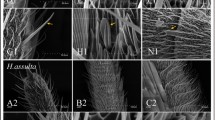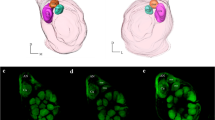Summary
A technique is described for the recording of receptor and action potentials from the outer dendritic segments of the olfactory cells in individual antennalSensilla trichodea in insects. The 50 μm long olfactory hairs on the antennae of adult male summerfruit toftrix moth,Adoxophyes orana, are shown to possess two cells responsive to the female sex pheromone (a 9∶1 mixture ofcis-9 andcis-11-TDA (= tetradecen-1-ol acetate)). One of these cells (typeB) is sensitive tocis-9-TDA, the other (type A) mainly responds tocis-11-TDA and, to a much smaller extent, tocis-9-TDA. The behavioural inhibitorstrans-9 andtrans-11-TDA evoke small responses in both cells, which may have been caused by contamination of these substances by thecis isomers (Fig. 6).
It appears that the pheromone receptor cells are not ‘tuned’ to the optimal 9∶1 mixture (Fig. 7). Hence, the attractiveness of the pheromone should be determined in the central nervous system by comparison of the responses from theA andB cells.
A rough calculation indicates that the males are very well able to discriminate between different mixture ratios. It is suggested that thecis-9-/cis-11-TDA ratio excreted by the females shows a considerable variation.
Similar content being viewed by others
References
Albert, P. J., Seabrook, W.D., Paim, U.: Isolation of a sex pheromone receptor in males of the eastern spruce budworm,Choristoneura fumiferana (Clem.), (Lepidoptera: Tortricidae). J. comp. Physiol.91, 79–89 (1974)
Behrend, K.: Riechen in Wasser und in Luft beiDytiscus marginalis L. Z. vergl. Physiol.75, 108–122 (1971)
Boeckh, J.: Elektrophysiologische Untersuchungen an einzelnen Geruchsrezeptoren auf den Antennen des Totengräbers (Necrophorus, Coleoptera). Z. vergl. Physiol.46, 212–248 (1962)
Boeckh, J.: Reaktionsschwelle, Arbeitsbereich und Spezifität eines Geruchsrezeptors auf der Heuschreckenantenne. Z. vergl. Physiol.55, 378–406 (1967a)
Boeckh, J.: Inhibition and excitation of single insect olfactory receptors, and their role as a primary sensory code. In: Olfaction and taste, Vol. 2 (ed. T. Hayashi), pp. 721–735. Oxford: Pergamon Press 1967b
Boeckh, J.: Electrical activity in olfactory receptor cells. In: Olfaction and taste, Vol. 3 (ed. C. Pfaffmann), pp. 34–51. New York: The Rockefeller University Press 1969
Boeckh, J., Kaissling, K.-E., Schneider, D.: Insect olfactory receptors. Cold Spr. Harb. Symp. quant. Biol.30, 263–280 (1965)
Cardé, R.T., Baker, T.C., Roelofs, W.L.: Sex attractant responses of male Oriental fruit moths to a range of component ratios: Pheromone polymorphism? Experientia (Basel)32, 1406–1407 (1976)
Davis, E.E.: A receptor sensitive to oviposition site attractants on the antennae of the mosquito,Aedes aegypti. J. Insect Physiol.22, 1371–1376 (1976)
Den Otter, C.J.: Differential sensitivity of insect chemoreceptors to alkali cations. J. Insect Physiol.18, 109–131 (1972)
Den Otter, C.J.: Electrophysiology of sex pheromone sensitive cells on antennae of the summerfruit tortrix moth,Adoxophyes orana. Abstr. 1st Congr. European Chemoreception Research Organization, Paris, p. 45 (1974)
Den Otter, C.J.: Electrophysiology of pheromone receptor cells in the summerfruit tortrix moth,Adoxophyes orana. Abstr. 2nd Congr. European Chemoreception Research Organization, Reading (U.K.), p. 55 (1976)
Dethier, V.G., Schoonhoven, E.M.: Olfactory coding by lepidopterous larvae. Entomol. exp. appl.12, 535–543 (1969)
Dumpert, K.: Alarmstoffrezeptoren auf der Antenne vonLasius fuliginosus (Latr.) (Hymenoptera, Formicidae). Z. vergl. Physiol.76, 403–425 (1972)
Gillary, H.L.: Stimulation of the salt receptor of the blowfly. III. The alkali halides. J. gen. Physiol.50, 359–368 (1966)
Green, D.M., Swets, J.A.: Signal detection theory and psychophysics. New York: John Wiley and Sons 1966
Kafka, W.A.: Molekulare Wechselwirkungen bei der Erregung einzelner Riechzellen. Z. vergl. Physiol.70, 105–143 (1970)
Kafka, W.A., Ohloff, G., Schneider, D., Vareschi, E.: Olfactory discrimination of two enantiomers of 4-methyl-hexanoic acid by the migratory locust and the honeybee. J. comp. Physiol.87, 277–284 (1973)
Kaissling, K.-E.: Insect olfaction. In: Handb. sens. physiol., Vol. IV. Chemical senses 1. Olfaction (ed. L.M. Beidler), pp. 351–431. Berlin-Heidelberg-New York: Springer 1971
Kaissling, K.-E.: Topical stimulation of the outer dendrites of single olfactory cells in saturniid moths. Abstr. 1st Congr. European Chemoreception Research Organization, Paris, p. 26 (1974 a)
Kaissling, K.-E.: Sensory transduction in insect olfactory receptors. In: Biochem. of sens. functions (ed. L. Jaenicke), pp. 243–273. Berlin-Heidelberg-New York: Springer 1974b
Kaissling, K.-E., Priesner, E.: Die Riechschwelle des Seidenspinners. Naturwissenschaften57, 23–28 (1970)
Kaissling, K.-E., Renner, M.: Antennale Rezeptoren für Queen Substance und Sterzelduft bei der Honigbiene. Z. vergl. Physiol.59, 357–361 (1968)
Kay, R.E.: Olfactory unit potentials and receptor potential responses ofLucilia sericata. Amer. J. Physiol.220, 1481–1487 (1971)
Kellog, F.E.: Water vapour and carbon dioxide receptors inAedes aegypti. J. Insect Physiol.16, 99–108 (1970)
Kochansky, J., Tette, J., Taschenberg, E.F., Cardé, R.T., Kaissling, K.-E., Roelofs, W.L.: Sex pheromone of the moth,Antheraea polyphemus. J. Insect Physiol.21, 1977–1983 (1975)
Lacher, V.: Elektrophysiologische Untersuchungen an einzelnen Rezeptoren für Geruch, Kohlendioxyd, Luftfeuchtigkeit und Temperatur auf den Antennen der Arbeitsbiene und der Drohne (Apis mellifica L.). Z. vergl. Physiol.48, 587–623 (1964)
Lacher, V.: Elektrophysiologische Untersuchungen an einzelnen Geruchsrezeptoren auf den Antennen weiblicher Moskitos (Aëdes aegypti L.). J. Insect Physiol.13, 1461–1470 (1967)
Lacher, V.: Ein neuer Sensillentyp auf den Antennen weiblicher Moskitos (Aedes aegypti L.). Experientia (Basel)25, 768–769 (1969)
Lacher, V., Schneider, D.: Elektrophysiologischer Nachweis der Riechfunktion von Porenplatten (Sensilla placodea) auf den Antennen der Drohne und der Arbeitsbiene (Apis mellifica L.). Z. vergl. Physiol.47, 274–278 (1963)
Maes, F.W., Den Otter, C.J.: Relationship between taste cell responses and arrangement of labellar taste setae in the blowflyCalliphora vicina. J. Insect Physiol.22, 377–384 (1976)
Meijer, G.M., Ritter, F.J., Persoons, C.J., Minks, A.K., Voerman, S.: Sex pheromones of summer fruit tortrix mothAdoxophyes orana: Two synergistic isomers. Science175, 1469–1470 (1972)
Minks, A.K., Roelofs, W.L., Ritter, F.J., Persoons, C.J.: Reproductive isolation of two tortricid moth species by different ratios of a two-component sex attractant. Science180, 1073–1074 (1973)
Minks, A.K., Roelofs, W.L., Schuurmans-Van Dijk, E., Persoons, C.J., Ritter, F.J.: Electroantennogram responses of two tortricid moths using two-component sex pheromones. J. Insect Physiol.20, 1659–1665 (1974)
Minks, A.K., Voerman, S.: Sex pheromones of the summerfruit tortrix moth,Adoxophyes orana: Trapping performance in the field. Entomol. exp. appl.16, 541–549 (1973)
Mood, A.M., Graybill, F.A., Boes, D.C.: Introduction to the theory of statistics. Tokyo: McGraw-Hill Kogakusha Ltd. 1974
Morita, H., Yamashita, S.: Receptor potentials recorded from sensilla basiconica on the antenna of the silkworm larvae,Bombyx mori. J. exp. Biol.38, 851–861 (1961)
Mountcastle, V.B.: Sensory receptors and neural encoding: Introduction to sensory processes. In: Medical physiology, Vol. 1 (ed. V.B. Mountcastle), pp. 285–306. Saint Louis: The C.V. Mosby Company 1974
Mustaparta, H.: Responses of single olfactory cells in the pine weevilHylobius abietis L. (Col.: Curculionidae). J. comp. Physiol.97, 271–290 (1975)
Nagata, K., Tamaki, Y., Noguchi, H., Yushima, T.: Changes in sex pheromone activity in adult females of the smaller tea tortrix mothAdoxophyes fasciata. J. Insect Physiol.18, 339–346 (1972)
O'Connell, R.J.: Responses of olfactory receptors to the sex attractant, its Synergist and inhibitor in the red-banded leaf roller,Argyrotaenia velutinana. In: Olfaction and taste, Vol. 4 (ed. D. Schneider), pp. 180–186. Stuttgart: Wissenschaftliche Verlagsgesellschaft 1972
O'Connell, R.J.: Olfactory receptor responses to sex pheromone components in the red-banded leafroller moth. J. gen. Physiol.65, 179–205 (1975)
Ritter, F.J.: Some recent developments in the field of insect pheromones. Meded. Fakult. Landbouwwet. Gent.36, 874–882 (1971)
Schneider, D.: Electrophysiological investigation on the antennal receptors of the Silk Moth during chemical and mechanical stimulation. Experientia (Basel)13, 89–91 (1957a)
Schneider, D.: Elektrophysiologische Untersuchungen von Chemo- und Mechanorezeptoren der Antenne des SeidenspinnersBombyx mori L. Z. vergl. Physiol.40, 8–41 (1957b)
Schneider, D.: Electrophysiological investigation on the olfactory specificity of sexual attracting substances in different species of moths. J. Insect Physiol.8, 15–30 (1962)
Schneider, D., Boeckh, J.: Rezeptorpotential und Nervenimpulse einzelner olfaktorischer Sensillen der Insektenantenne. Z. vergl. Physiol.45, 405–412 (1962)
Schneider, D., Hecker, E.: Zur Elektrophysiologie der Antenne des SeidenspinnersBombyx mori bei Reizung mit angereicherten Extrakten des Sexuallockstoffes. Z. Naturforsch.11b, 121–124 (1956)
Schneider, D., Lacher, V., Kaissling, K.-E.: Die Reaktionsweise und das Reaktionsspektrum von Riechzellen beiAntheraea pernyi (Lepidoptera, Saturniidae). Z. vergl. Physiol.48, 632–662 (1964)
Schoonhoven, L.M., Dethier, V.G.: Sensory aspects of host-plant discrimination by lepidopterous larvae. Arch. Néerl. Zool.16, 497–530 (1966)
Tamaki, Y., Noguchi, H., Yushima, T., Hirano, C., Honma, K., Sugawara, H.: Sex pheromone of the summerfruit tortrix: Isolation and identification. Kontyû39, 338–340 (1971)
Vareschi, E.: Duftunterscheidungen bei der Honigbiene. Einzelzell-Ableitungen und Verhaltensreaktionen. Z. vergl. Physiol.75, 143–173 (1971)
Vareschi, E.: Single cell response and odor-discrimination in the honey-bee. In: Olfaction and taste, Vol. 4 (ed. D. Schneider), pp. 187–192. Stuttgart: Wissenschaftliche Verlagsgesellschaft 1972
Author information
Authors and Affiliations
Additional information
I am much indebted to Prof. Dr. D. Schneider for the use of facilities in his laboratory at the Max-Planck-Institut für Verhaltensphysiologie, Seewiesen (Federal Republic of Germany), and to all colleagues at this laboratory, especially Dr. K.-E. Kaissling, for their help. I am also grateful to Dr. F.W. Maes, Department of Zoology, State University of Groningen (Netherlands), for many discussions and his very valuable suggestions and help. I thank Drs. A.K. Minks and S. Voerman, Laboratory for Research on Insecticides, Wageningen (Netherlands), for the supply of the maleA. orana pupae and the chemicals; Mrs. C. Huss-Hahn, Mrs. G.W. De Vries-Nijboer and Miss M.J. Den Otter for technical assistance; Mr. D. Visser for preparing the figures; and Dr. G. Thomas for correcting the English text and constructive criticism. The investigations were supported by the Alexander von Humboldt-Stiftung and the Netherlands Organization for the Advancement of Pure Research (ZWO).
Rights and permissions
About this article
Cite this article
Den Otter, C.J. Single Sensillum responses in the male mothAdoxophyes orana (F.v.R.) to female sex pheromone components and their geometrical isomers. J. Comp. Physiol. 121, 205–222 (1977). https://doi.org/10.1007/BF00609612
Received:
Issue Date:
DOI: https://doi.org/10.1007/BF00609612




